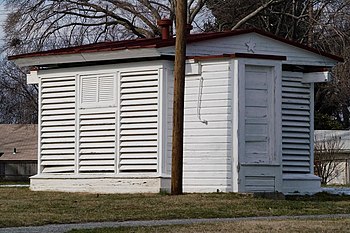The National Geodetic Survey and the Office of Coast Survey are the two successor agencies in the United States to the U.S. Coast and Geodetic Survey. It was first established by President Thomas Jefferson in 1807 as the Survey of the Coast. Progress moved ahead slowly and haltingly during the first 25 years. Not until August 29, 1811 did Mr. F. R. Hassler sail for Europe to obtain the proper instruments. He remained in Europe during the War of 1812, then he returned to the United States on August 16, 1815 with the proper instruments.
Mr. Hassler's plans were to employ triangulation to establish his system. Work began in the vicinity of New York City in 1816. The first base line was measured and verified in 1817. A new Act of Congress interfered with the work of Mr. Hassler in 1818. The army and navy were placed at the forefront of the Survey which generated a lull in activity which lasted from 1818 to 1832. Little work was produced until another Act of Congress was passed on July 10, 1832. It re-empowered the original Act of 1807. Mr. Hassler was re-appointed as the superintendent, and field work was resumed in April, 1833.
The Coast survey was without a superintendent during the 14 years from 1818 to 1832 when the army was the primary authority. The Navy Department was given the control of the survey from 1834 to 1836, but the Treasury department resumed the administration of the survey on March 26, 1836. Hassler died in 1843.
Professor Alexander Dallas Bache became superintendent of the Survey in 1843. Earlier in his life, he had established the first magnetic observatory. During his years as superintendent, he expanded the Survey southward along the Atlantic coast into the Florida Keys. He instituted regular and systematic observations of the tides and the Gulf Stream, and investigated magnetic forces and directions.
As the American continent was progressively explored, inhabited and enclosed, the bureau took responsibility for survey of the interior. In 1878 it reorganized as the Coast and Geodetic Survey (C&GS). Since 1970, the National Geodetic Survey has been part of the National Oceanic and Atmospheric Administration within the United States Department of Commerce.
During the nineteenth century, the remit of the Survey was rather loosely drawn and it had no competitors in federally funded scientific research. Various Superintendents developed its work in fields as diverse as astronomy, cartography, meteorology, geodesy, geology, geophysics, hydrography, navigation, oceanography, exploration, pilotage, tides and topography.
From 1836 until the establishment of the National Bureau of Standards in 1901, the Survey was responsible for weights and measures throughout the US.
 Ships of the Survey
Ships of the Survey
Ferdinand Rudolph Hassler (c. 1818-1843) [1]
Joseph Saxton, (1843–1873);

No comments:
Post a Comment